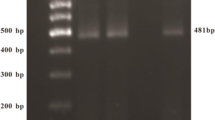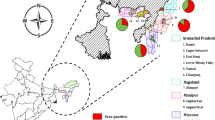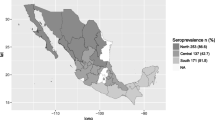Abstract
Hepatitis E virus (HEV) infection has been recognised as an important cause of acute viral hepatitis of zoonotic importance globally. This study evaluated the haematological, serum biochemical and histopathological changes in HEV seropositive pigs. A total of 120 pigs were sourced from the Bodija Municipal abattoir, Ibadan, Nigeria, for this study. The haematology and serum biochemistry of the sampled pigs seropositive to HEV antibodies using the ID Screen® Hepatitis E Indirect Multi-species ELISA biwell kit were analysed. Liver and spleen samples were also taken for histopathological examination and lesion scoring. HEV seropositivity was reported in 57.5% (69/120) of the pigs and associated with a significant (p < 0.05) decrease in erythrocyte parameters with a tendency to a non-regenerative anaemia. A significant moderate thrombocytopenia (1.81 ± 0.82 × 105/μL) was also observed in the HEV seropositive group. There was a significant elevation in the level of serum hepatocellular leakage enzymes (aspartate transaminase and sorbitol dehydrogenase), albumin and total bilirubin level in the seropositive group. A semiquantitative analysis of the lesion score also revealed a significantly higher frequency and severity of hepatic lesions (including hepatocellular vacuolation, necrosis, lymphoplasmacytic infiltration, Kupffer cell hyperplasia and fibrosis) in the seropositive group. This study underscores the need for further HEV studies in Nigeria as an important tentative aetiology in porcine hepatitis.

Similar content being viewed by others
References
Aggarwal R, Jameel S (2011) Hepatitis E. Hepatology 54:2218–2226. https://doi.org/10.1002/hep.24674
Alkali BR, Bello MB, Hussaini S, Onwuliri CO (2015) Serological evidence and public health implication of hepatitis E virus infection in pigs found in Zaria, Kaduna state. Afr J Microbiol Res 9:2270–2274. https://doi.org/10.5897/AJMR2015.7555
Amarapurkar DN, Amarapurkar AD (2002) Extrahepatic manifestations of viral hepatitis. Ann Hepatol 1
Antia R, Adekola A, Jubril A, Ohore O, Emikpe B (2018) Hepatitis E virus infection seroprevalence and the associated risk factors in animals raised in Ibadan, Nigeria. J Immunoass Immunochem 39:509–520. https://doi.org/10.1080/15321819.2018.1514507
Bain P (2011) Liver. In: Latimer KS (ed) Duncan and Prasse’s veterinary laboratory medicine. Clinical pathology. Wiley-Blackwell, Hoboken, pp 173–178
Balayan M, Usmanov R, Zamyatina D, Karas F (1990) Brief report: experimental hepatitis E infection in domestic pigs. J Med Virol 32:58–59
Bazerbachi F, Haffar S, Garg SK, Lake JR (2016) Extra-hepatic manifestations associated with hepatitis E virus infection: a comprehensive review of the literature. Gastroenterol Rep 4:1–15. https://doi.org/10.1093/gastro/gov042
Behrendt P, Steinmann E, Manns MP, Wedemeyer H (2014) The impact of hepatitis e in the liver transplant setting. J Hepatol 61:1418–1429. https://doi.org/10.1016/j.jhep.2014.08.047
Colson P, Payraudeau E, Leonnet C, De Montigny S, Villeneuve L, Motte A, Tamalet C (2008) Severe thrombocytopenia associated with acute hepatitis E virus infection. J Clin Microbiol 46:2450–2452. https://doi.org/10.1128/JCM.02295-07
IBM Corporation (2016) IBM SPSS statistics for windows
Craighead JE (2000) Pathology and pathogenesis of human viral disease. Academic, Cambridge 10/cv2w6k
de Carvalho LG, Marchevsky RS, dos Santos DRL, de Oliveira JM, de Paula VS, Lopes LM, der Poel WHM, González JE, Munné MS, Moran J, Cajaraville ACRA, Pelajo-Machado M, Cruz OG, Pinto MA (2013) Infection by Brazilian and Dutch swine hepatitis E virus strains induces haematological changes in Macaca fascicularis. BMC Infect Dis 13:1–11. https://doi.org/10.1186/1471-2334-13-495
Dong C, Meng J, Dai X, Liang J-H, Feagins AR, Meng X-J, Belfiore NM, Bradford C, Corn JL, Cray C, Glass GE, Gordon ML, Hesse RA, Montgomery DL, Nicholson WL, Pilny AA, Ramamoorthy S, Shaver DD, Drobeniuc J, Purdy MA, Fields HA, Kamili S, Teo C-G (2011) Restricted enzooticity of hepatitis E virus genotypes 1 to 4 in the United States. J Clin Microbiol 49:4164–4172. https://doi.org/10.1128/JCM.05481-11
Evans EW (2011) Proteins, lipids, and carbohydrates, In: Duncan and Prasse’s veterinary laboratory medicine. Clinical pathology. Wiley-Blackwell, Hoboken, pp 172–202
Fourquet E, Mansuy JM, Bureau C, Recher C, Vinel JP, Izopet J, Péron JM (2010) Severe thrombocytopenia associated with acute autochthonous hepatitis E. J Clin Virol 48:73–74. https://doi.org/10.1016/j.jcv.2010.02.016
Gibson-Corley KN, Olivier AK, Meyerholz DK (2013) Principles for valid histopathologic scoring in research. Vet Pathol 50:1007–1015. https://doi.org/10.1177/0300985813485099
Halbur PG, Kasorndorkbua C, Gilbert C, Guenette D, Potters MB, Purcell RH, Emerson SU, Toth TE, Meng XJ (2001) Comparative pathogenesis of infection of pigs with hepatitis E viruses recovered from a pig and a human. J Clin Microbiol 39:918–923. https://doi.org/10.1128/JCM.39.3.918-923.2001
Hill AB (1965) The environment and disease: association or causation? Proc R Soc Med 58:295–300
Ikeda T, Morimoto A, Nakamura S, Yokoyama K, Hayase T, Oh Y, Kashii Y, Yotsumoto S, Okamoto H, Momoi MY (2012) A marked decrease in CD4-positive lymphocytes at the onset of hepatitis in a patient with hepatitis-associated aplastic anemia. J Pediatr Hematol Oncol 34:375–377. https://doi.org/10.1097/MPH.0b013e31822bf699
Junaid SA, Agina SE (2014) Haematological changes associated with hepatitis E virus seropositivity among human and animal subjects in plateau state, Nigeria. Int Blood Res Rev 2:311–321
Kamar N, Selves J, Mansuy J-M, Ouezzani L, Péron J-M, Guitard J, Cointault O, Esposito L, Abravanel F, Danjoux M, Durand D, Vinel J-P, Izopet J, Rostaing L (2008) Hepatitis E virus and chronic hepatitis in organ-transplant recipients. N Engl J Med 358:811–817. https://doi.org/10.1056/NEJMoa0706992
Kamar N, Izopet J, Pavio N, Aggarwal R, Labrique A, Wedemeyer H, Dalton HR (2017) Hepatitis E virus infection. Nat Rev Dis Primers 3:1–16. https://doi.org/10.1038/nrdp.2017.86
Kasorndorkbua C, Halbur PG, Thomas PJ, Guenette DK, Toth TE, Meng XJ (2002) Use of a swine bioassay and a RT-PCR assay to assess the risk of transmission of swine hepatitis E virus in pigs. J Virol Methods 101:71–78. https://doi.org/10.1016/S0166-0934(01)00420-7
Kasorndorkbua C, Thacker BJ, Halbur PG, Guenette DK, Buitenwerf RM, Royer RL, Meng X-J (2003) Experimental infection of pregnant gilts with swine hepatitis E virus. Can J Vet Res 67:303–306
Krawczynski K, McCaustland K, Mast E, Yarbough P, Purdy M, Favorov M, Speilbring J (1996) Elements of pathogenesis of HEV infection in man and experimentally infected primates. In: Buisson Y, Coursaget P, Kane M (eds) Enterically-transmitted hepatitis viruses. La Simarre, Tours, pp 317–328
Latimer KS, Mahaffey EA, Prasse KW, Duncan JR (2011) Duncan and Prasse’s veterinary laboratory medicine : clinical pathology, 5th edn. Wiley-Blackwell, Hoboken
Li C, Wang HF (2011) Hepatitis E virus-related acute liver failure associated with pure red cell aplasia. Hepatobiliary Pancreat Dis Int 10:557–558. https://doi.org/10.1016/S1499-3872(11)60096-9
Li L, Zhu Y, Fu H, Wei X, Wang L, Liang J, Ji Y, Tang R, Zhuang H (2009) Full-genome nucleotide sequence and analysis of a Chinese swine hepatitis E virus isolate of genotype 4 identified in the Guangxi Zhuang autonomous region: evidence of zoonotic risk from swine to human in South China. Liver Int 29:1230–1240. https://doi.org/10.1111/j.1478-3231.2009.02012.x
Liu P, Bu QN, Wang L, Han J, Du RJ, Lei YX, Ouyang YQ, Li J, Zhu YH, Lu FM, Zhuang H (2013) Transmission of hepatitis E virus from rabbits to cynomolgus macaques. Emerg Infect Dis 19:559–565. https://doi.org/10.3201/eid1904.120827
Liu P, Du R j, Wang L, Han J, Liu L, Zhang Y l, Xia J k, Lu F m, Zhuang H (2014) Management of Hepatitis E Virus (HEV) zoonotic transmission: protection of rabbits against HEV challenge following immunization with HEV 239 vaccine. PLoS One 9:e87600. https://doi.org/10.1371/journal.pone.0087600
Masood I, Rafiq A, Majid Z (2014) Hepatitis E presenting with thrombocytopaenia. Trop Dr 44:219–220. https://doi.org/10.1177/0049475514521610
Meng XJ (2003) Swine hepatitis E virus: cross-species infection and risk in xenotransplantation. Curr Top in Microbiol Immunol 278:185–216
Meng XJ (2010a) Hepatitis E virus: animal reservoirs and zoonotic risk. Vet Microbiol 140:256–265. https://doi.org/10.1016/j.vetmic.2009.03.017
Meng XJ (2010b) Recent advances in hepatitis e virus. J Viral Hepat 17:153–161. https://doi.org/10.1111/j.1365-2893.2009.01257.x
Meng XJ, Purcell RH, Halbur PG, Lehman JR, Webb DM, Tsareva TS, Haynes JS, Thacker BJ, Emerson SU (1997) A novel virus in swine is closely related to the human hepatitis E virus. Proc Natl Acad Sci U S A 94:9860–9865. https://doi.org/10.1073/pnas.94.18.9860
Okamoto H (2007) Genetic variability and evolution of hepatitis E virus. Virus Res 127:216–228. https://doi.org/10.1016/j.virusres.2007.02.002
Purcell RH, Emerson SU (2001) Hepatitis E virus. In: Knipe D, Howley P (eds) Fields virology, vol 2. Lippincott Williams & Wilkins, Philadelphia, pp 3051–3061
Reyes GR, Purdy MA, Kim JP, Luk KC, Young LM, Fry KE, Bradley DW (1990) Isolation of a cDNA from the virus responsible for enterically transmitted non-a, non-B hepatitis. Science (New York, NY) 247:1335–1339. https://doi.org/10.1126/science.2107574
Ruggeri F, Di Bartolo I, Ostanello F, Trevisani M (2013) Hepatitis E virus: an emerging zoonotic and foodborne pathogen, hepatitis E virus: an emerging zoonotic and foodborne pathogen. Springer, Berlin. https://doi.org/10.1007/978-1-4614-7522-4
Shah SAR, Lal A, Idrees M, Hussain A, Jeet C, Malik FA, Iqbal Z, Rehman H u (2012) Hepatitis E virus-associated aplastic anaemia: the first case of its kind. J Clin Virol 54:96–97. https://doi.org/10.1016/j.jcv.2012.02.002
Smith DB, Simmonds P, Jameel S, Emerson SU, Harrison TJ, Meng XJ, Okamoto H, Van der Poel WHM, Purdy MA (2014) Consensus proposals for classification of the family Hepeviridae. J Gen Virol 95:2223–2232. https://doi.org/10.1099/vir.0.068429-0
Sridhar S, Teng JLL, Chiu TH, Lau SKP, Woo PCY (2017) Hepatitis E virus genotypes and evolution: emergence of camel hepatitis E variants. Int J Mol Sci 18. https://doi.org/10.3390/ijms18040869
Sun ZF, Larsen CT, Dunlop A, Huang FF, Pierson FW, Toth TE, Meng XJ (2004) Genetic identification of avian hepatitis E virus (HEV) from healthy chicken flocks and characterization of the capsid gene of 14 avian HEV isolates from chickens with hepatitis-splenomegaly syndrome in different geographical regions of the United States. J Gen Virol 85:693–700. https://doi.org/10.1099/vir.0.19582-0
Sun Y, Du T, Liu B, Syed SF, Chen Y, Li H, Wang X, Zhang G, Zhou EM, Zhao Q (2016) Seroprevalence of avian hepatitis E virus and avian leucosis virus subgroup J in chicken flocks with hepatitis syndrome, China. BMC Vet Res 12:261. https://doi.org/10.1186/s12917-016-0892-4
Tahaei SME, Mohebbi SR, Zali MR (2012) Enteric hepatitis viruses. Gastroenterol Hepatol Bed Bench. https://doi.org/10.1016/S0168-7069(07)17003-8
Tam AW, Smith MM, Guerra ME, Huang CC, Bradley DW, Fry KE, Reyes GR (1991) Hepatitis E virus (HEV): molecular cloning and sequencing of the full-length viral genome. Virology 185:120–131. https://doi.org/10.1016/0042-6822(91)90760-9
Thapa R, Biswas B, Mallick D, Ghosh A (2009) Acute pancreatitis - complicating hepatitis E virus infection in a 7-year-old boy with glucose 6 phosphate dehydrogenase deficiency. Clin Pediatr 48:199–201. https://doi.org/10.1177/0009922808327107
Vitral CL, Pinto MA, Lewis-Ximenez LL, Khudyakov YE, Santos DR, Maria A, Gaspar C (2005) Serological evidence of hepatitis E virus infection in different animal species from the southeast of Brazil. Mem Inst Oswaldo Cruz 100:117–122. https://doi.org/10.1590/S0074-02762005000200003
Wedemeyer H, Pischke S, Manns MP (2012) Pathogenesis and treatment of hepatitis e virus infection. Gastroenterology. 142:1388–1397.e1. https://doi.org/10.1053/j.gastro.2012.02.014
Yang Y, Shi R, She R, Soomro MH, Mao J, Du F, Zhao Y, Liu C (2015) Effect of swine hepatitis E virus on the livers of experimentally infected Mongolian gerbils by swine hepatitis E virus. Virus Res 208:171–179. https://doi.org/10.1016/j.virusres.2015.06.007
Zamvar V, McClean P, Odeka E, Richards M, Davison S (2005) Hepatitis E virus infection with nonimmune hemolytic anemia. J Pediatr Gastroenterol Nutr 40:223–225. https://doi.org/10.1097/00005176-200502000-00027
Acknowledgments
The authors wish to appreciate the butchers, abattoir personnel and farmers for their cooperation during the sample collection phase of the study. We would like to thank the technicians of the Clinical and the Diagnostic Pathology Unit of the Department of Veterinary Pathology for their support during the sample collection and processing phase of the study.
Funding
This study was conducted as part of the research for the Master’s in Veterinary Pathology (Clinical) degree programme by Adewole Adekola for which he received the University of Ibadan Postgraduate Research Support Grant through the Centre for Control and Prevention of Zoonosis (CCPZ) approved at the rates on the John D. and Catherine T. MacArthur Foundation Grant (Grant No. 97944).
Author information
Authors and Affiliations
Contributions
Study concept and design: AAA, REA, BOE; data collection and field work: AAA, AJJ; acquisition, analysis, or interpretation of data: AAA, OGO; slide reading and scoring: AAA, AJJ; statistical analysis: AAA; manuscript draft: AAA, AJJ; critical revision of the manuscript for important intellectual content: REA, BOE; OGO; All authors read and approved the final manuscript.
Corresponding author
Ethics declarations
Ethical approval
All applicable international, national, and/or institutional guidelines for the care and use of animals were followed.
Conflict of interest
The authors declare that they have no conflict of interest.
Additional information
Publisher’s note
Springer Nature remains neutral with regard to jurisdictional claims in published maps and institutional affiliations.
Rights and permissions
About this article
Cite this article
Adekola, A.A., Antia, R.E., Jubril, A.J. et al. Haematological, serum biochemical and histopathological changes in hepatitis E virus seropositive pigs in Ibadan, Nigeria. Comp Clin Pathol 28, 1537–1546 (2019). https://doi.org/10.1007/s00580-019-02956-5
Received:
Accepted:
Published:
Issue Date:
DOI: https://doi.org/10.1007/s00580-019-02956-5




